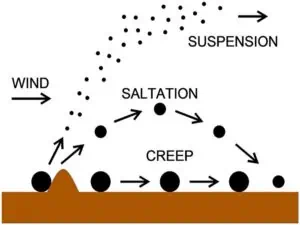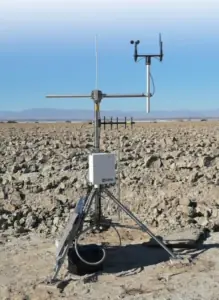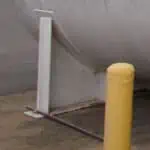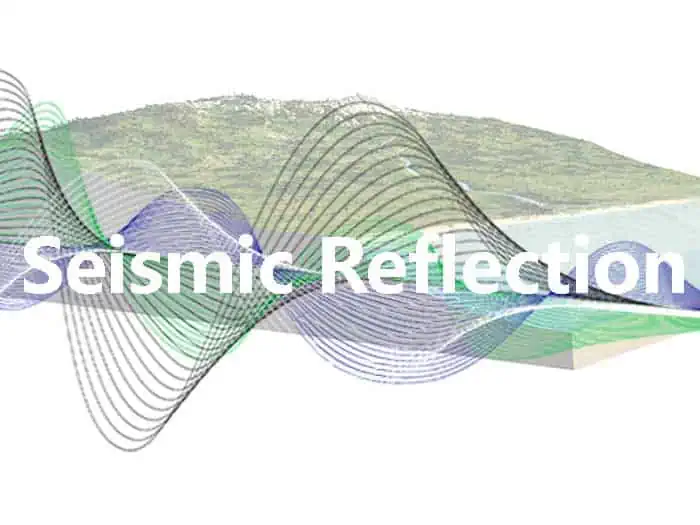

Wind, sand, and dust storms will become more prevalent as the dry season approaches. One phenomenon that occurs during dust storms is saltation. Saltation is a method of particle transport driven by a fluid—in this case, wind.

Finer particulates (<0.1mm) are generally suspended in the moving fluid, are carried into the atmosphere, and can be brought back down to the surface via precipitation. These particulates can travel over hundreds of miles. Coarser particulates (0.5 – 1mm) exhibit “soil creep,” where they roll, slide, or are pushed along with the wind, rarely coming off the surface.
Mid-range particulates—those that fall in the 0.1 – 0.5mm range—are subject to saltation. With wind speeds that hit a critical value, these particulates are carried by the wind and exhibit a lifting and falling motion, similar to bouncing. Once the particle has gained enough acceleration, it can either (1) collide with particles on the ground and dislodge them into motion at wind velocities lower than those required to move them by wind alone. This process is called reptation. Or (2) through the process of attrition, break into smaller particles upon impact and continue the loop. Saltation occurs within 30cm of the surface and accounts for 50 – 90% of the total movement of soil by wind.
Regardless of the mechanism, these Aeolian processes create ripples and dunes in the landscape. Sand accumulates on the windward side and slides down the leeward face. Both ripples and dunes are comprised of an asymmetrical wave with longer, gradual upwind slopes and shorter, steeper downwind slopes.
Sand and dust storms generally occur in arid and semi-arid regions but are also prevalent in agricultural areas and coastal zones. Notable areas in California that are subject to these storms are the Salton Sea, Mono Lake, the Central Valley area, as well as coastal dunes. These environments exhibit either sparse or nonexistent vegetation cover, plenty of fine sediment such as clay, silt, or sand, and relatively strong winds. The winds mobilize the sand and dust, resulting in major impacts on the environment, economy, and human health.
We can assess the emissions of particulates due to saltation in a few ways.
Sand Flux Measurements
Saltating particles travel relatively small distances during wind events, so measurements of horizontal sand flux can indicate the amount of wind erosion occurring. One method for conducting sand flux measurements requires two instruments: a Cox Sand Catcher (CSC)— essentially a particle collection bin—and a Sensit—a real-time particle impact sensor. Placing the inlet of the Sand Catcher and the sensor of the Sensit at the same height, generally 15cm above the surface, assures accuracy. These two instruments are collocated at sites 100 – 1000m apart, and placing additional CSC units in the field without collocated Sensits provides better spatial resolution.
Sample tubes within the Sand Catchers are collected monthly, or more frequently during windy periods, and then delivered to the gravimetric lab for weighing. Sensits use a piezo electrical crystal to continuously detect and measure saltation activity as particle count and kinetic energy. Saltation flux is a mass measurement of particles that pass horizontally through a vertical plane; this is measured in units of mass/area, as opposed to PM concentration, measured in units of mass/volume.
Once this is determined, PM can be estimated using dispersion modeling programs such as AERMOD or CALPUFF.

Particle Counters
The SANTRI (Standalone AeoliaN Transport Real-time Instrument) is a particle counter that operates on the principle of interruptions through a wavelength of light. It counts particles as they pass through an infrared beam, detecting up to seven (7) different grain-size ranges.
SANTRIs require a solar panel and a water-resistant electrical enclosure containing a 12V lead-acid battery to provide power. The enclosure mounts on a freely rotating pole with a wind vane attached, allowing it to align with the wind direction.
One problem with the SANTRI as an optical sensor is it can overestimate particle transport when particles moving largely outside the detection beam are partially registered and counted. Alternatively, finer particles may cause insufficient attenuation of the beam signal and, in turn, are underestimated.
Particulate Matter Monitoring
Ambient particulate matter monitors such as Tapered Element Oscillating Microbalances (TEOMs) and Beta Attenuation Monitors (BAMs) log hourly concentrations of PM10 or PM2.5.
TEOMs are gravimetric instruments that pull ambient air through a filter at a constant flow rate, simultaneously weigh the filter, and calculate the real-time mass concentration.
DustTraks Monitors are real-time, near reference instruments that can measure PM1, PM2.5, Respirable, PM10, and PM Total at the same time. It uses a light-scattering photometer. Due to their low power consumption, they can deploy easily in remote areas and help develop a correlation between Saltation and PM concentration in specific areas according to the soil type.
Studies show a strong positive correlation between saltation flux and downwind PM concentrations. Measuring saltation can allow us to estimate particulate matter lofted into the air we breathe; however, the inverse isn’t always true.
Depending on the local conditions, there are different means to reduce the occurrence or compounding effects of saltation. Soil properties, topography, and meteorology are driving factors. Common methods are:
Nature can create beautiful landscapes of seemingly endless rolling waves of sand, but it can also be a major source of economic and human loss. As the climate continues to experience extremes, water scarcity and drought will further exasperate this problem in the western United States, among other regions with similar climate patterns. Lakes have been and will continue to dry and recede, exposing playa, and consequently, a major source of minerals and hyper saline particles subject to saltation.
Measurements of these natural phenomena can help us understand and plan for coexisting with nature in areas prone to wind events and storms. Measurement studies involving installing systems to quantify, assess, and control particulate matter in various locations surrounding a source—while costly and time-consuming as measurements take place on a years-long basis—are highly informative and help us adapt or create environmental solutions.

If you are interested in a career where your work matters to human health and the environment as Eva’s does — we’d enjoy hearing from you!
In a nutshell, the Brownfields Reauthorization Act of 2023 reauthorizes the Brownfields Program through Fiscal Year 2029 and makes the program more accessible to small and disadvantaged communities. The legislation does so by reducing financial barriers to participation and by encouraging greater community participation in decision-making processes. The following are highlights:
Additional Resources to Jump Start Your Community Project:
SCS Engineers is thrilled to welcome Carrie Ridley to the Wichita, Kansas, office. Carrie is a licensed professional geologist joining us from the Kansas Geological Survey, where she held Project Manager and Principal Investigator roles for Department of Energy projects. These projects focused on Carbon Capture, Utilization and Storage, and investigation into Critical Minerals.
Prior to that, she spent four years as the Geology and Well Technology Chief within the Kansas Department of Health and Environment. There, she managed the federally designated UIC 1422 program, the Underground Hydrocarbon Storage and Water Well Contractors programs. Prior to UIC work, she worked for six years with the RCRA program in the Bureau of Waste Management as a project manager. Carrie spent ten years with the Kansas Department of Transportation in the Topeka Geology office to begin her career after receiving her MS degree from Kansas State University.
Carrie brings extensive knowledge of state and federal funding, project development, and contracting programs. We are excited to have her join our Deep Well Injection and Carbon Sequestration team.
Monte Markley, our Deep Well and Carbon Sequestration National Expert states, “We are excited to have Carrie join SCS; her extensive knowledge of the UIC universe will benefit our clients and further strengthen our team.”
If you’d like to work with experts such as Carrie Ridley on work to preserve our quality of life – visit SCS.
Unexpectedly replacing a tank can strain your budget and always seems to come at the most inopportune times. Based on my experience with tank inspections, one of the most common reasons for unexpected tank replacements is using an Underground Storage Tank (UST) as an Aboveground Storage Tank (AST).
Any STI/SPFA SP001 Certified Inspector can identify a misused UST during the required periodic inspections of ASTs, and these tanks are also commonly discovered during site visits related to drafting or updating Spill Prevention, Control, and Countermeasure (SPCC) Plans. Budget and complete a tank replacement before your next inspection. During my inspections, I use three indicators when looking at a tank to identify if a UST is misused as an AST:
No Emergency Vent! The most important reason not to use a UST aboveground.
If the unthinkable happens and you have a fire around your tank without proper emergency venting, that tank fire can go from bad to BOOM!
The design of ASTs is to minimize the danger of being engulfed in flames to release the vapors from the tank in a controlled manner. In contrast, a UST design will never be engulfed in flames, so the tank manufacturer does not install an emergency vent port.
Properly sizing an AST emergency vent to release the increased vapor pressure during a fire is important, too. The need to release the higher pressure makes emergency vents much larger than the normal vents for simple atmospheric changes. The larger emergency vents come in five varieties:
Flip-up vents are spring-loaded caps held closed by a latch designed to release at a set pressure or temperature. If the latch doesn’t work and the flip-up cap is open, duct tape or a well-placed brick is not the proper solution; you’ll need to replace the latch. Luckily, the latches are readily available, and the latch installation is usually simple.
Rupture disks are vent covers where the entire cover breaks open when a set pressure or temperature is exceeded, instead of just the latch like in the flip-up vents.
Pop-up vents are weighted caps that sit on the vent until the pressure in the tank reaches the designed level. During fire incidents, these vents periodically release the built-up vapors, preventing the tank from rupturing. If this vent is not staying seated correctly, repair or replace the vent.
Long bolt manholes function similarly to the pop-up vents to periodically release built-up vapors. This type of vent relies on the bolts securing the manhole cover to have the designed amount of slack between the manhole rim and the nuts. I’ve seen too many long bolt manholes with the nuts fully tightened to the rim, completely negating the vent’s purpose and safety. A simple fix for this issue is to replace the fully threaded bolts with properly sized partially threaded bolts.
New tanks are unlikely to have Weak Roof-to-Shell joints. Occasionally, I’ve seen them in older single-wall vertical tanks, where the roof construction has a particular area break when the tank pressure gets too high.
Unreviewed Damage: Most USTs as ASTs are old and damaged
Frequently pulling these tanks results in dents or scraps to the UST. Remove any damaged tanks from service until a qualified inspector or engineer can review the damage. Additionally, most states prohibit the reuse of USTs once they are removed from their original installation location.
It may be difficult to see in this image, but the tank is scratched, dented, and starting to rust.

Most of the repurposed USTs are horizontal, so these tanks require chocks or an earthen berm to keep them in place. Saddles act as the welded attachment areas for the tank legs and distribute the weight over the tank’s belly — part of the AST design. Sometimes, people with good intentions get too creative and attempt to turn a UST into a vertical AST. However, the presence of vent connections along the side of the tank and none on the tank top is a sure sign the tank is not in use appropriately.
Best practice — look for these warning signs before inspections and drafting or updating SPCC Plans.

The Tennessee Composting Council is hosting its 1st Annual Composting Conference at the Community Foundation of Middle Tennessee in lovely Nashville, TN, on November 8, 2023.
The agenda will feature key presentations on the state of composting in Tennessee. Network with industry members and learn how you can affect change in your community through composting initiatives.

Don’t miss Composting Facility Design, Equipment, Permitting, and Other Operational Considerations at 11-12 p.m. with Gregory McCarron, VP of SCS Engineers.
Register today!
Taking a Critical Step Towards Net Zero Emissions Using Carbon Sequestration
The picturesque California Delta, often referred to as the Sacramento-San Joaquin Delta, is emerging as a geological sweet spot in California’s ambitious journey toward reaching net zero carbon emissions. Its unique geology presents a compelling case for carbon sequestration, an essential strategy in the battle against climate change. Recent developments, including a collaborative effort between SCS and Lawrence Livermore National Laboratory (LLNL) on a Class VI permit application for Pelican Renewables – a company formed by Delta landowners and residents to pursue geologic storage – are indicative of the region’s growing importance in California’s carbon mitigation strategy.
Geological Foundations of Carbon Sequestration in the California Delta
The California Delta, often referred to as the Sacramento-San Joaquin Delta, is a vast inland delta formed by the confluence of the Sacramento and San Joaquin rivers and their tributaries as they meet the waters of the San Francisco Bay. Its unique geology makes it an ideal candidate for carbon sequestration:
California’s Net Zero Carbon Goal and Carbon Sequestration in the Delta
California has set an ambitious goal to achieve net zero carbon emissions by 2045, a milestone in the fight against climate change. Achieving this objective necessitates reducing emissions and actively removing and storing carbon from the atmosphere. Carbon sequestration in the California Delta can play a pivotal role in this endeavor. The Delta’s geological potential aligns seamlessly with the state’s commitment to sustainable practices and environmental responsibility.
Collaborative Efforts: SCS and LLNL’s Support for Pelican Renewables’ Class VI Permit Application
The collaboration between SCS Engineers and Lawrence Livermore National Laboratory (LLNL) that supported geologic characterization, modeling, and CO2 injection simulation for Pelican Renewables’ injection well application underscores the importance of pursuing carbon sequestration in the California Delta. The Class VI permit application underlines Pelican’s commitment to conducting carbon capture and storage (CCS) activities with the highest safety and environmental standards. This initiative is a testament to the growing synergy between scientific research and private enterprise in addressing climate challenges.
References and Further Reading
For a deeper dive into California’s carbon removal options for reaching net zero, “Getting to Neutral” by LLNL is a valuable resource. This publication outlines the various strategies and technologies under research to achieve California’s ambitious carbon reduction goals, including carbon sequestration in regions like the California Delta. The most recent “Scoping Plan” by the California Air Resources Board – the state’s policy blueprint for achieving its climate goals – underscores the need to capture and store CO2 from large sources and the atmosphere.
Our Conclusions
The California Delta’s geological attributes make it an attractive destination for carbon sequestration, a critical component in California’s mission to achieve net zero carbon emissions. Collaborative endeavors like SCS’s ongoing partnership with LLNL and Pelican Renewables highlight the commitment to responsible carbon capture and storage practices. As we continue to innovate and harness the potential of our natural surroundings, the California Delta’s role in addressing climate change becomes increasingly evident and essential.
Carbon Sequestration Considerations & Resources

Millions in FY24 Brownfields Grants Available – Deadline for Submissions is November 13, 2023
EPA anticipates awarding an estimated 60 Community-wide Assessment Grants for an estimated total of $30 million, subject to the quality of applications received, availability of funds, and other applicable considerations.
A Community-wide Assessment Grant is appropriate for communities beginning to address their brownfield challenges and for communities with ongoing efforts to bring sites into productive reuse. The project period for Community-wide Assessment Grants is up to four years.
FY 2024 Technical Assistance to Tribal Nations and Entities Addressing Brownfields Grant $4 million, with a $4 m ceiling, one grant expected
FY 2024 Multipurpose Grants $20 million, with a $1 m ceiling, 20 grants expected
FY 2024 Community-wide Assessment Grants $30 million, with a $.5 m ceiling, 60 grants expected
FY 2024 Assessment Coalition Grants $40 million, with a $1.5 m ceiling, 26 grants expected
FY 2024 Community-wide Assessment Grants for States and Tribes $50 million, with a $2 m ceiling, 25 grants expected
FY 2024 Cleanup Grants $95 million, with a $5 m ceiling, 65 grants expected
The closing date and time for receipt of applications is November 13, 2023, 11:59 p.m. Eastern Time (ET). You must submit applications through https://www.grants.gov/. Please take a look at the Due Date and Submission Instructions in Section IV.B. and Appendix 1 for more instructions.
Please contact your EPA regional support staff or SCS Engineers at for help. We’re happy to help answer questions.
SCS Engineers is a Bronze Sponsor at the upcoming Southern California Association of Non-Profit Housing (SCANPH) Conference in Pasadena. Join our Environmental Professionals at our display table #28 at the Pasadena Convention Center on November 1st. This annual event represents 35 years of building together: Building our industry’s capacity and building impact in our communities.
Join our Environmental Professionals at Display Table #28. Talk with Ashley Hutchens and Tyler Watkins, about your environmental challenges!

Commercial Carbon Capture and Sequestration in the US
The US is home to the largest number of commercial carbon capture and sequestration (CCS) projects worldwide, with approximately 50 new projects announced in 2021, according to the Global CCS Institute. SCS contributes expertise to several ongoing and groundbreaking carbon dioxide geologic sequestration projects. These projects have highly advanced permitting and monitoring requirements.
Research published in a report by the Congressional Research Service defines three main types of sites ideal for underground CO2 injection and sequestration: depleted oil and gas reservoirs, deep saline reservoirs, and un-mineable coal seams. In each case, CO2 in a supercritical state is injected into a porous rock formation below ground that holds, or previously held, fluids. When injected at depths greater than half a mile, the pressure keeps the injected CO2 entrained within the formation fluids, where the CO2 will subsequently dissolve.
Selecting a Site
The target geological injection interval must have an overlying impermeable caprock, such as shale, so the injected CO2 doesn’t migrate into overlying formations, most specifically, the underground source of drinking water. Fortunately for geoscientists and engineers, most of the technology used to assess the subsurface was initially developed by the petroleum industry, including a variety of geophysical techniques, including seismic reflection.
Using Seismic Reflection Technology
At SCS, our team uses the same seismic reflection technology and methodology developed by the oil and gas industry to evaluate the subsurface. Seismic reflection is a powerful tool when used properly and allows us to interpret the depositional background of the system and identify permeable and impermeable units. Seismic reflection involves generating seismic waves (the source) and measuring the two-way travel time taken for the waves to travel from the source, reflect off an interface, and be detected by an array of receivers at the surface. The reflected signal is based on the density-velocity contrast at the interface. Depending upon the type of source and receivers, seismic reflection, once recorded and processed, provides 2 or 3-D imagery of stratigraphic boundaries and geologic structure –all at depths ranging from hundreds of meters to several kilometers.
In-house experts enable SCS to utilize this amazing tool, which enables teams across the organization to see where the best areas for injection are by interpreting seismic stratigraphy. We can determine the continuity of a layer and the presence (or absence) of faults and fractures. The data can also help us determine the type of fault and whether it is a sealing or a transmissive fault. For example, a fault-bound anticline (when the rocks push up from stress changes) may provide a stratigraphic trap for hydrocarbon and can potentially store CO2.
We use seismic reflection in the initial phases of a project to determine the depths and lateral extent of known lithology. We employ previously mapped lithologic units to correlate the “images” created in seismic profiles to existing formations and, in doing so, perform a “check” on the seismic interpretation.
Long Term Benefits
Seismic reflection provides significant input when choosing a reservoir or siting a well; however, its use doesn’t end with an initial site assessment. The technology provides robust methods for monitoring the CO2 plume and interpreting changes to the subsurface during and post-injection. SCS has two Class VI injection projects where seismic reflection data was employed to identify the target injection zones and seals. The next step will be using the data to look at the subsurface relative to the injection well using downhole sensors, a process known as vertical seismic profiling.
The requirements surrounding the Class VI permitting process are complicated, but SCS has in-house experts with the skills to employ seismic reflection. Teams continue to hone their skills in this area as clients value and trust partners who can demonstrate a thorough understanding of permitting carbon sequestration projects.
The Class VI permit application typically takes 18 to 24 months to receive approval. The process is laborious and expensive. Demonstrating expertise here is critical as SCS Engineers continues to play an integral role in advancing supercritical CO2 projects throughout North America.
Additional Resources and Educational Materials:

Florida SWANA will host its 2024 Winter Conference, “Together Towards Tomorrow”, February 19-21 at the new Drury Plaza Hotel Orlando in Lake Buena Vista, Florida.
Conference host is developing an interesting and educational agenda of sessions and speakers who will discuss the latest developments in the solid waste industry. This will be an excellent time to share with and learn from your peers. For industry suppliers and service providers, this is a great opportunity to showcase your company’s products and services.
This multi-day conference will include general sessions on best practices in the solid waste management profession, networking events and more.
The conference is targeted towards local, state and municipal government solid waste directors, managers, regulators, operators and coordinators; in addition to private sector consulting engineers and suppliers of materials and equipment used in the management of solid waste.
Topics may include:
Click for more conference details and registration information. Plenty of SCS Engineers professionals will be there – we hope you will too!